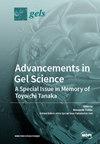Preparation and Effect of CO2 Response Gel for Plugging Low-Permeability Reservoirs
IF 5
3区 化学
Q1 POLYMER SCIENCE
引用次数: 0
Abstract
In order to solve the problem of gas channeling during CO2 flooding in low-permeability reservoirs, a novel CO2 responsive gel channeling system was prepared by using carrageenan, branched polyethylene imide and ethylenediamine under laboratory conditions. Based on the Box–Behnken response surface design method, the optimal synthesis concentration of the system was 0.5 wt% carrageenan, 2.5 wt% branchized polyethylenimide and 6.5 wt% ethylenediamine. The micromorphology of the system before and after response was characterized by scanning electron microscopy. The rheology and dehydration rate were tested under different conditions. The channeling performance and enhanced oil recovery effect of the gel system were simulated by a core displacement experiment. The experimental results show that the internal structure of the system changes from a disordered, smooth and loosely separated lamellae structure to a more uniform, complete and orderly three-dimensional network structure after exposure to CO2. The viscosity of the system was similar to aqueous solution before contact with CO2 and showed viscoelastic solid properties after contact with CO2. The experiment employing dehydration rates at different temperatures showed that the internal structure of the gel would change at a high temperature, but the gel system had a certain self-healing ability. The results of the displacement experiment show that the plugging rate of the gel system is stable at 85.32% after CO2 contact, and the recovery rate is increased by 17.06%, which provides an important guide for the development of low-permeability reservoirs.用于堵塞低渗透储层的二氧化碳响应凝胶的制备及其效果
为了解决低渗透储层二氧化碳充注过程中的气体导流问题,在实验室条件下,利用卡拉胶、支化聚乙烯亚胺和乙二胺制备了一种新型二氧化碳响应凝胶导流体系。根据盒-贝肯响应面设计法,该体系的最佳合成浓度为 0.5 wt%的卡拉胶、2.5 wt%的支化聚乙烯亚胺和 6.5 wt%的乙二胺。用扫描电子显微镜观察了反应前后体系的微观形态。在不同条件下测试了流变性和脱水率。通过岩心置换实验模拟了凝胶体系的通道性能和提高采油效果。实验结果表明,暴露于 CO2 后,体系内部结构由无序、光滑、松散分离的层状结构转变为更加均匀、完整、有序的三维网络结构。在接触二氧化碳之前,该体系的粘度与水溶液相似,而在接触二氧化碳之后,则显示出粘弹性固体特性。不同温度下的脱水率实验表明,凝胶的内部结构在高温下会发生变化,但凝胶体系具有一定的自愈能力。位移实验结果表明,凝胶体系与二氧化碳接触后的堵塞率稳定在 85.32%,采收率提高了 17.06%,为低渗透油藏的开发提供了重要指导。
本文章由计算机程序翻译,如有差异,请以英文原文为准。
求助全文
约1分钟内获得全文
求助全文

 求助内容:
求助内容: 应助结果提醒方式:
应助结果提醒方式:


